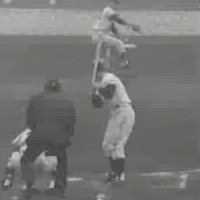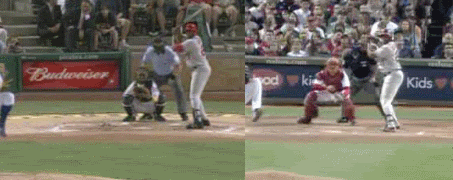quote:
Originally posted by S. Abrams:
XV
My friend sucks at golf; I can beat him blindfolded and give him mulligans all day....at the end of 18, I will own him. He swings a golf club like a bat...hand action is very different. No, there is no chance he thought of the golf swing when talking about baseball...he's an engineer and a very focused one at that.
Torque is still a bad choice of words, sorry.
The hands are producing force to rotate the bat about a pivot point (axis). That is torque to me.
quote:
Some questions for you to ponder:
Do you think that the hands are the sole cause of forearm rotation in pronation/supination? What point/points of the swing does/do supination and pronation take place?
That's not a correct way to word it. The hands are connected to the forearms. The hands rotate with the forearms. BUT, mentally focusing on the hands and using cues to describe what the hands do usually works better compared to the forearms. You are free to use cues for the forearms or wrists if you wish.
You can use the words hands, forearms, or wrists interchangeably. When I say "pronation of the hand", "pronation of the wrist", or "pronation of the forearm", they all describe the same action. "Forearm rotation" can be one of either pronation or supination. When I say "forearm rotation" in the context of the swing, I mean "pronation of the bottom hand and supination of the top hand" collectively just so that I don't have to write it all out.
Those who start with a position where the bat is more vertical, or one where the bat is pointing toward the pitcher/middle infielders, are definitely rotating their forearms earlier and through a longer range of motion in order to get the bat "on plane". Those whose bats are more diagonal (from the front view) are using their forearms through a shorter range of motion.
The difference between the high level swings and low level ones, is that the high level ones "start" this forearm rotation before committing to the pitch. This is "early bat speed". They start it with their muscles. Just because you see no "movement of the bones" does not mean there is no "action". This gives the bat early momentum. No "dead hands" swing.
Quincy does not understand muscle contractions, therefore, he believes if a joint is not changing angles, there is no muscle contraction. He believes that when a muscle contracts it always shortens, in other words, the joint angle always change. In other words, "there is movement". I can stand upright on two feet, and contract my quads and nothing happens. I can stand on two feet and contract my hamstrings and nothing happens. No joint angles in my knees, hips, or ankles change. Until Quincy understands muscle contractions, he won't know what I have been posting about for the past few days.
S.Abrams, what is your understanding of muscle contractions?
quote:
Does slotting the elbow effect early bat speed? Why or why not?
Yes. Having the elbow tucked to the ribs puts you in a stronger position to swing. The elbow responds to the hands. You don't want the hands to be a "slave" to the elbows. The starting position of the elbow is personal preference. Some hitters start high (David Wright) and some low (Jeff Kent). It's just a checkpoint, not something to teach. Something to look for on video, not something to give a mental cue for. If the hands/forearms are working properly, the elbow will respond properly. Actually, I look a both elbows as check points.
quote:
Explain how the hips respond to the hands? Or is it vice versa?
The more resistance you feel in your hands, the greater the stretch you can create in separation, the more powerful the "releasing" of this stretch occurs. More resistance in your hands helps keep the upper body closed while the front hip is opening.
The front leg/knee/hip should be opening into footplant while the hands are getting the bat on plane.

quote:
Do you think the hands control bat path and bat plane? If so, how? If not, what does control path and plane?
Yes. What else are the hands suppose to do? What else is suppose to control the bat? The shoulders respond to the hands, not the other way around. The hands get the bat on plane by way of pronation and supination of the forearms. The amount and intensity will very upon pitch location and speed, of course.
Here is an example of the all-time home run king in Japan, taking two pitches while his hands are continually getting the bat on plane. As you can see he gets the bat on plane, even though he does not commit to the pitches. The second one, the ball is farther from the catcher's mitt yes, but look at where the catcher's mitt is. It is on plane with his bat.

quote:
What role do the hips and torso play in "early bat speed"? How? Do they play a role at all? Why?
The hips aid in separation. A "stronger" separation means more load at the hands, therefore, more resistance for the hands to respond to. The hips are part of the overall swing. This thread is regarding the hands and the handle, so I haven't mentioned much about the hips.
The front hip should be "clearing" while the bat is getting on plane. Early bat speed can be used to describe this "getting on plane" because the bat will blur.
quote:
What role does the bottom hand play in early bat speed? If yes, how? If no, why not?
The bottom hand works opposite of the top hand. If they are both working in the same direction, your swing plane will be wrong in addition to no early bat speed.
quote:
Is there a difference in the hip rotation in a high/knee lift stride/no stride/normal stride? Is there a difference? If so, why? If not, why not?
The stride is a style issue, not technique. The key is to not have all the weight on the front leg until the swing is committed as well have the hips slightly opened at footplant. We can discuss the hips more in another thread.
quote:
Ohh, by the way...the abilty to adjust to 95mph fastballs, 75 mph curves and 60 mph knucklers has alot more to do with pitch recognition than batspeed. Guess what...nobody ( except Jesus Christ) hits a good 75 mph curve after a 95 mph fastball unless he is guessing curve all the way. The only thing you hands will adjust is your cup.
You can hit a bad curve ( i.e. flat; a mistake) but not a good one. And if you're guessing curve outside and get the 90 mph ( don't even need 95) you get smoked, even Bonds.
You can stand in the box all day and without looking into the catcher's mitt be able to call every single pitch type, speed, and location, it tells me nothing about what you can do with the bat.
Pitch recognition is part of succeeding as a hitter I agree. But this discussion is about mechanics. You can see the ball, but if you don't know how to get the bat there, it means nothing. Although, I believe visual abilities can be genetically limited.
The only MLB player that could (probably) hit any pitch (out of the park) on any count is Vlad Guerrero. Bonds is too disciplined.

quote:
XV, everybody wants to talk about the mechanics of hitting. That's cool but as long as hitting is an art instead of a science, they'll be sitting on the dock watching the boat sail away. The real hitters will be waving to them from the boat.
"Hitting is an art" is what the casual fan uses as an excuse to cover up for their lack of understanding of what is happening. The real hitters don't need to be taught, they need to be reminded. The ones sitting on the dock can't be reminded if they never knew in the first place.




